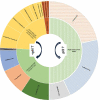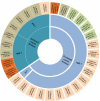Profuse diversity and acidogenicity of the candida-biome of deep carious lesions of Severe Early Childhood Caries (S-ECC)
- PMID: 34447489
- PMCID: PMC8386706
- DOI: 10.1080/20002297.2021.1964277
Profuse diversity and acidogenicity of the candida-biome of deep carious lesions of Severe Early Childhood Caries (S-ECC)
Abstract
Introduction: The retentive niches of deep caries lesions have a distinct biome. Methods: We evaluated the site-specific (occlusal and proximal) Candida-biome of Severe-Early Childhood Caries (S-ECC) in 66- children (132 lesions). Asymptomatic primary molars fitting the definition of the International Caries Detection and Assessment-(ICDAS)-caries-code 5/6 were analyzed. Deep-dentinal sampling and simultaneous assessment of pH were performed. Clinical isolates were speciated using multiplex-PCR and evaluated for their acidogenic and aciduric potential.Results: Surprisingly, a high prevalence of Candida species (72.7%), either singly or in combination, was noted from both the proximal and occlusal cavities. C. tropicalis was the most prevalent species (47%; 34/72), followed by C. krusei (43.1%; 31/72) and C. albicans (40.3%; 29/72), with C. glabrata being the least (9.7%; 7/72). Over 45% low-pH niches (pH <7) of both sites yielded either dual or triple species of Candida. Genotyping revealed three distinct C. albicans genotypes (A, B, and C) with (14/29; 48.3%) of strains belonging to Genotype A. All four evaluated Candida species exhibited acidogenic and aciduric potential, C. tropicalis being the most potent.Conclusion: This, the first report of the high-density, multispecies, yeast colonization of deep-dentinal lesions in S-ECC, suggests that the Candida-biome plays a significant etiologic role in the condition, possibly due to their profound acidogenicity in milieus rich in dietary carbohydrates.
Keywords: Severe early childhood caries; candida species; cavitated lesions; habitat; s-ecc.
© 2021 The Author(s). Published by Informa UK Limited, trading as Taylor & Francis Group.
Conflict of interest statement
No potential conflict of interest was reported by the author(s).
Figures




Similar articles
-
Diversity of site-specific microbes of occlusal and proximal lesions in severe- early childhood caries (S-ECC).J Oral Microbiol. 2022 Feb 13;14(1):2037832. doi: 10.1080/20002297.2022.2037832. eCollection 2022. J Oral Microbiol. 2022. PMID: 35173909 Free PMC article.
-
Candida biome of severe early childhood caries (S-ECC) and its cariogenic virulence traits.J Oral Microbiol. 2020 Feb 5;12(1):1724484. doi: 10.1080/20002297.2020.1724484. eCollection 2020. J Oral Microbiol. 2020. PMID: 32128040 Free PMC article.
-
Presence of candida in the dental plaque and saliva of patients with severe early childhood caries and early childhood caries:a pilot study.Eur Oral Res. 2024 May 5;58(2):102-107. doi: 10.26650/eor.20241067980. Eur Oral Res. 2024. PMID: 39011175 Free PMC article.
-
Oral Candida-biome and Early Childhood Caries: A Systematic Review and Meta-Analysis.Int Dent J. 2025 Apr;75(2):1246-1260. doi: 10.1016/j.identj.2024.08.020. Epub 2024 Sep 24. Int Dent J. 2025. PMID: 39322518 Free PMC article.
-
Is the oral fungal pathogen Candida albicans a cariogen?Oral Dis. 2018 May;24(4):518-526. doi: 10.1111/odi.12691. Epub 2017 Jun 13. Oral Dis. 2018. PMID: 28513096 Review.
Cited by
-
Diversity of site-specific microbes of occlusal and proximal lesions in severe- early childhood caries (S-ECC).J Oral Microbiol. 2022 Feb 13;14(1):2037832. doi: 10.1080/20002297.2022.2037832. eCollection 2022. J Oral Microbiol. 2022. PMID: 35173909 Free PMC article.
-
Streptococcus mutans serotyping, collagen-binding genes and Candida albicans in dentin carious lesions: a molecular approach.Clin Oral Investig. 2025 Jan 9;29(1):52. doi: 10.1007/s00784-024-06140-0. Clin Oral Investig. 2025. PMID: 39779540
-
Interactions between non-albicans Candida and Streptococcus mutans enhance cariogenic potential of dual-species interkingdom biofilms.J Oral Microbiol. 2025 Apr 14;17(1):2492198. doi: 10.1080/20002297.2025.2492198. eCollection 2025. J Oral Microbiol. 2025. PMID: 40235621 Free PMC article.
-
Application of mineral trioxide aggregate pulpotomy in the treatment of early pulpitis of primary molars.Am J Transl Res. 2024 Jan 15;16(1):285-294. doi: 10.62347/XVVC1010. eCollection 2024. Am J Transl Res. 2024. PMID: 38322556 Free PMC article.
-
Cross-kingdom interaction between Candida albicans and oral bacteria.Front Microbiol. 2022 Nov 3;13:911623. doi: 10.3389/fmicb.2022.911623. eCollection 2022. Front Microbiol. 2022. PMID: 36406433 Free PMC article. Review.
References
-
- Casamassimo PS, Thikkurissy S, Edelstein BL, et al. Beyond the dmft: the human and economic cost of early childhood caries. J Am Dent Assoc. 2009;140(6):650–657. Epub 2009/ 06/06. PubMed PMID: 19491160. - PubMed
-
- Hossain H, Ansari F, Schulz-Weidner N, et al. Clonal identity of Candida albicans in the oral cavity and the gastrointestinal tract of pre-school children. Oral Microbiol Immunol. 2003;18(5):302–308. - PubMed
LinkOut - more resources
Full Text Sources
